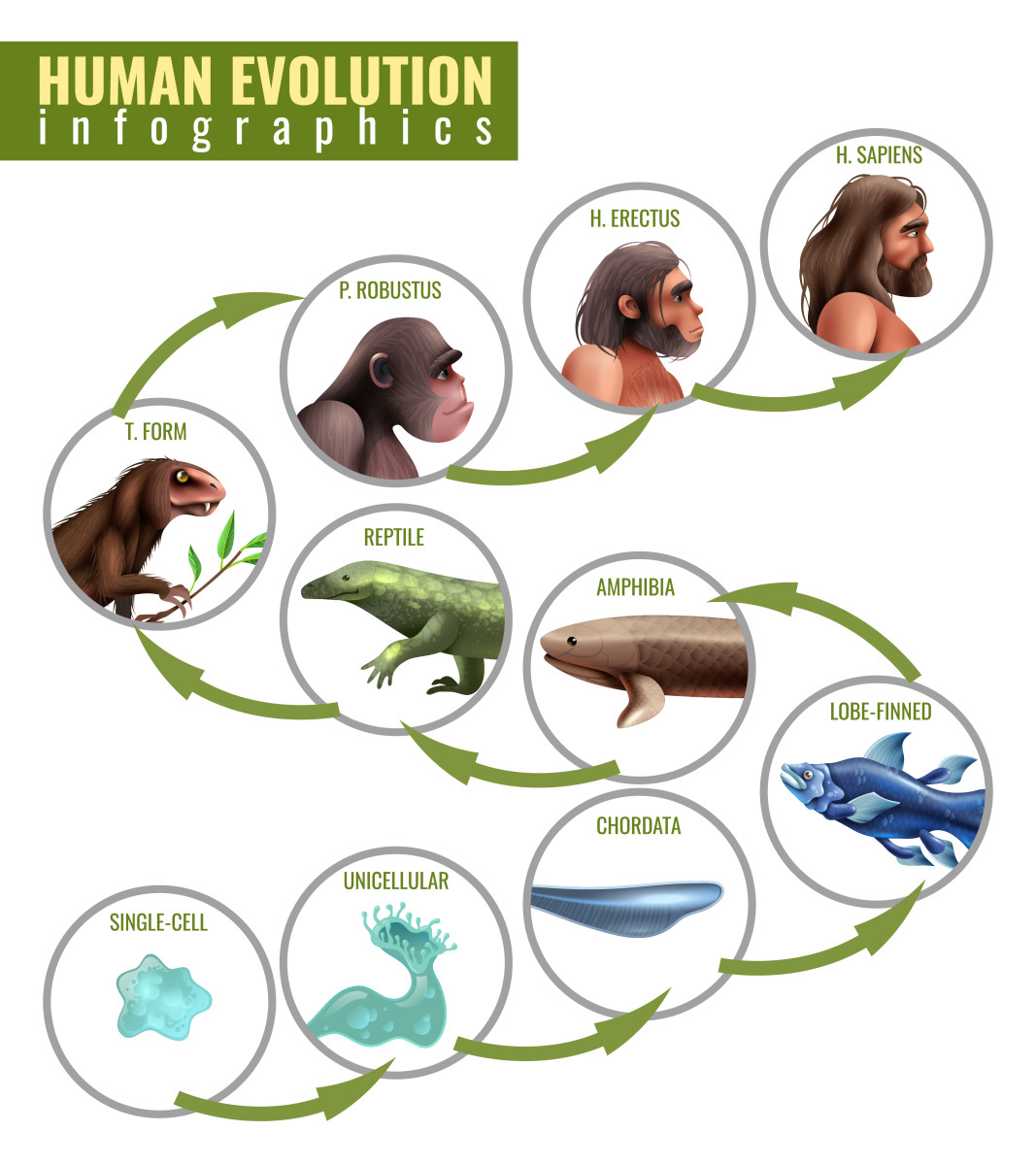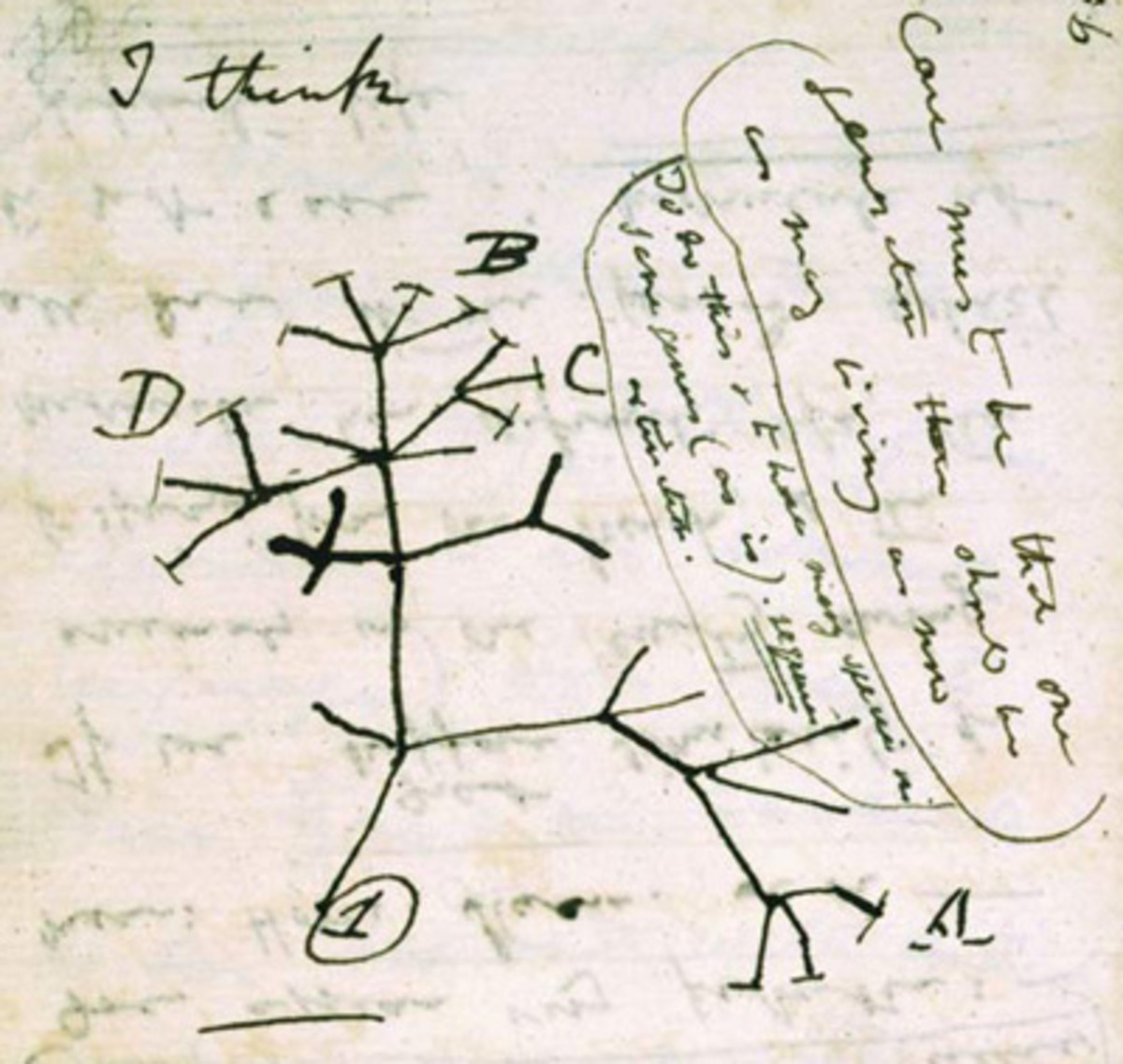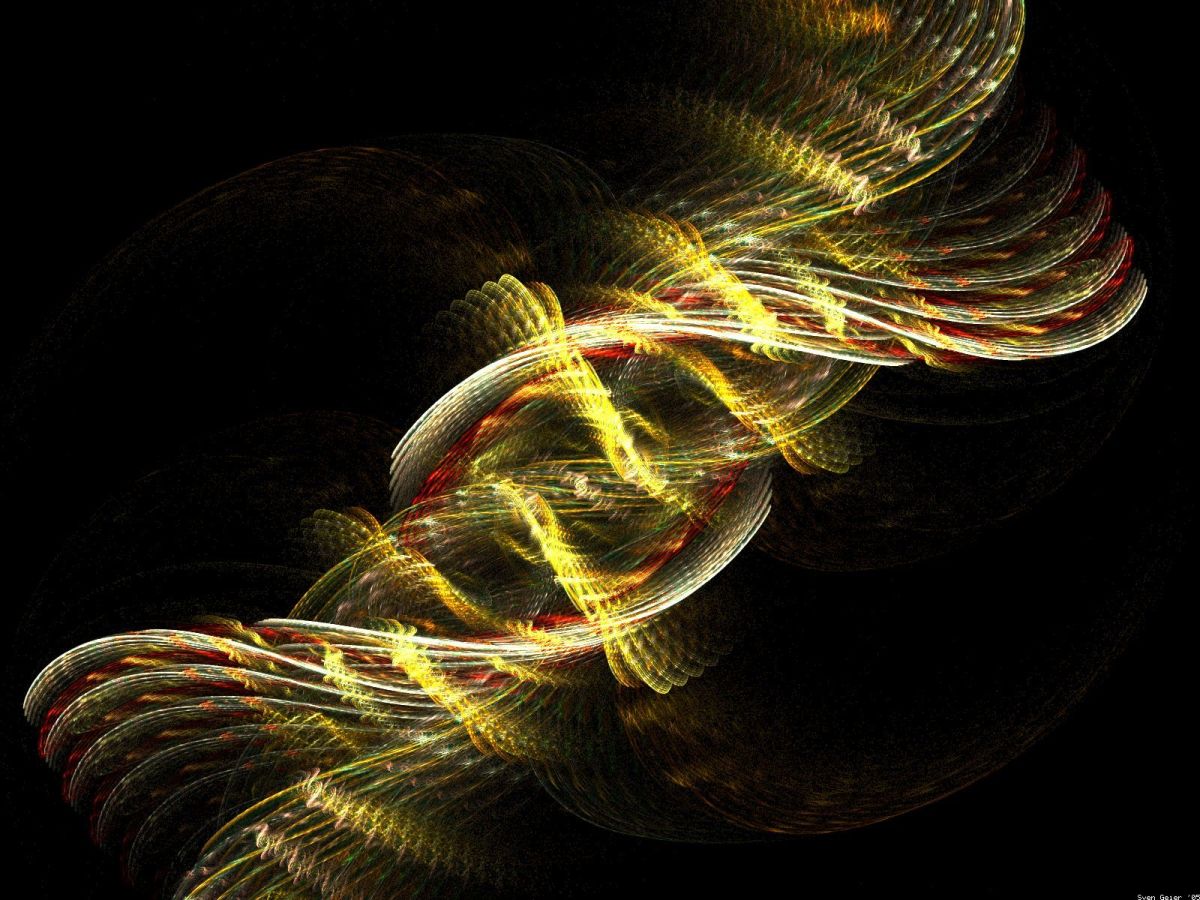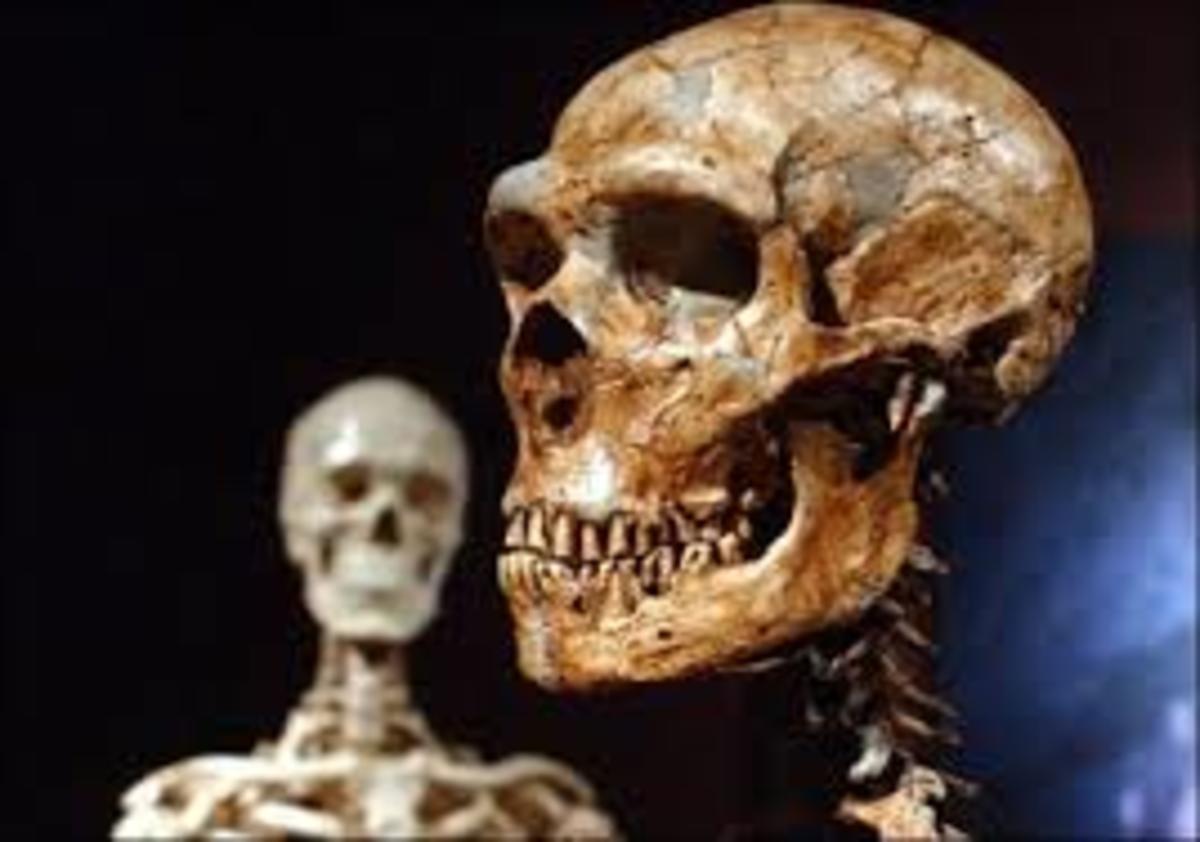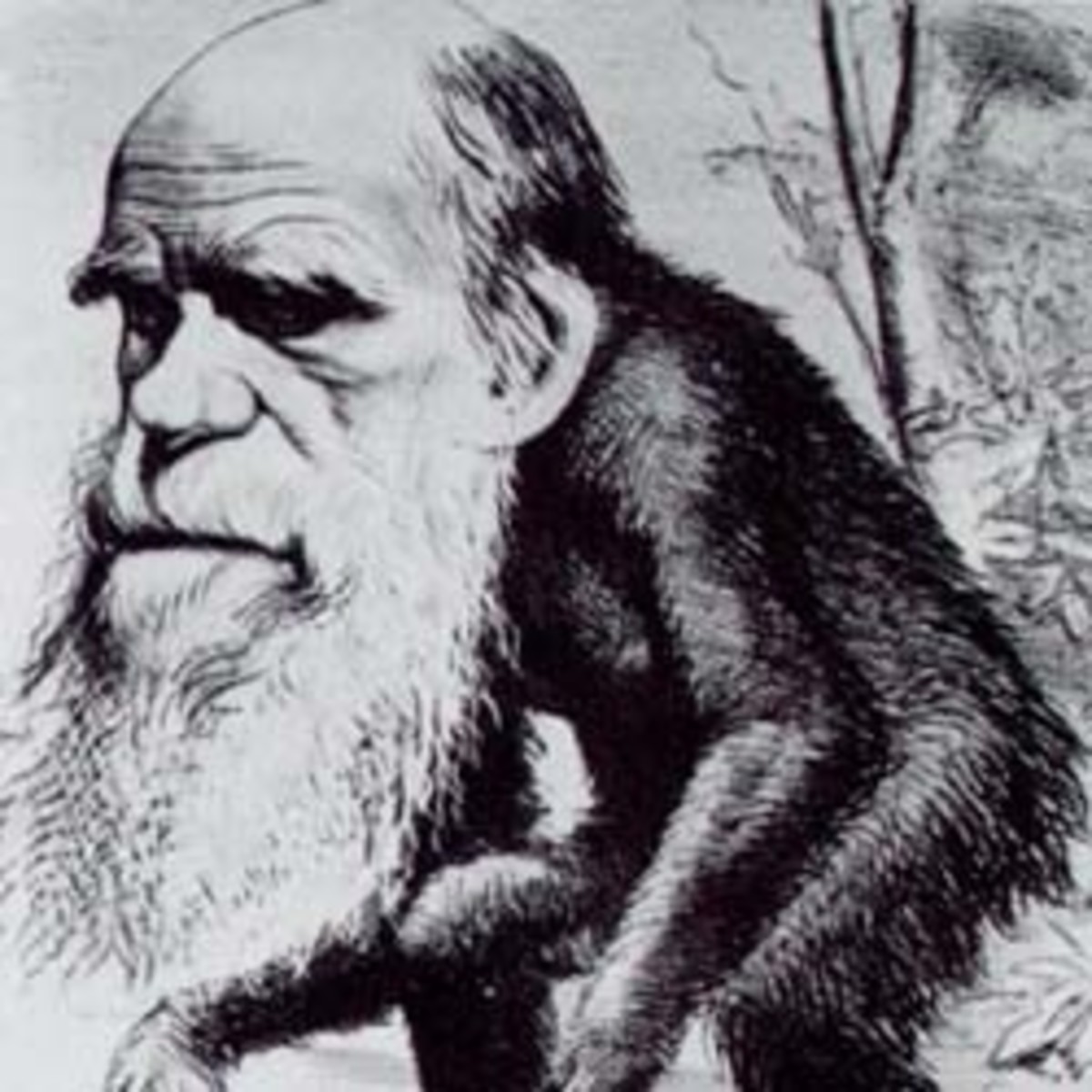Evolution It May be Weirder than We Suppose
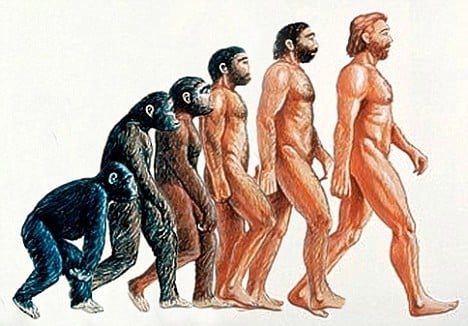
Our Origin it Turns Out, is Still Shrouded in Mystery
Where did human beings come from? We are told that humans were created and that they evolved from other species. Yet there are problems with both accounts. In the case of creation, humanity is far older than the 6,000 odd years given in the Biblical story. In the case of evolution, the difference in the number of chromosomes between primates and humans precludes any direct relationship between the two. Human beings thus where not created 6,000 years ago, not did they evolve from any known primate. There is evidence of human habitation far older than 6,000 years, but there is no missing link between humans and other primate candidates. We are thus stuck with a problem as to our origins. To answer this, we must ultimately answer the question of the origins of the cosmos itself and how it is that life got started in the first place. We know some hard facts, but much of the following, due to lack of hard facts, is hypothesis; an attempt to address our ignorance. The two main given accounts contain inaccuracies and gaps in information. We must then look to other sources of information in order to answer the questions once and for all; that is, our origins; when and whence we came into being. Let us then turn our attention to the usual and unusual in our quest.
-
Creation, by advanced being(s)
-
Evolution from an unknown ancestor
-
Engineered or refurbished?
-
A birth or births from two close, but unmatched species
-
A forced development owing to some catastrophic event
-
A chance confluence of random events
-
Environmental adaptation as the driver
It may be that we came about by one or more of the foregoing conditions. What we have been taught is not all inclusive and some of it has been determined to be lies and fraud. Religions teach us that all life on earth is created by very knowledgeable and powerful godlike beings. Evolution tells us that we evolved over the eons from simple life forms and that our closest living ancestors are the apes. Biological science gives us a different view that does not jive with the standard evolutionist view of the descent of species. There is no missing link between man and ape and there cannot be for the simple fact that all non-human apes have 24 sets of chromosomes and human beings only have 23 sets. We are told the chromosomes can fuse or split and this is offered as to why there is one less pair in humans compared to apes. But, a list of various species, that is far from complete, shows other confusions as well as some species have two or more different chromosome counts. Catastrophism has been acknowledged to be a driver of rapid changes in species by natural selection, so at least this part of the evolution story is largely correct. We have seen this ourselves as we try to outwit bugs and weeds in agriculture with a man-made catastrophe, only to find them adapted to our new poisons and able to flourish. They look like their older counterparts that were killed off by the same poisons, but they flourish in it and in some cases seem to relish the very poison that was once fatal. We have seen this in the field of medicine where super-bugs are now resistant to most anti-biotics. With our own human hands, we have managed by breeding alone, to create a huge variety of dogs of all shapes and sizes, whose common ancestors consisted of wolves and foxes. The idea that random events brought us to this point is the most far fetched of all, but it holds a fascination for many people.
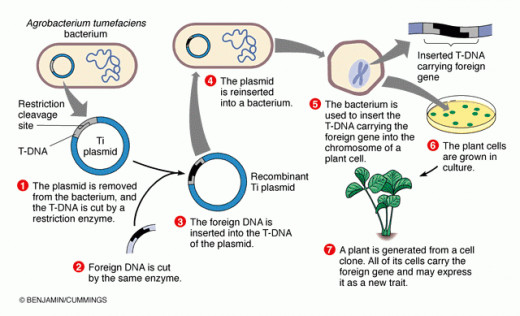
We are Now Directly Involved in Shaping Life
Humanity is currently experimenting with genetically modified organisms (GMO) and for the most part, we are like a blind person attempting to execute a piece of sculptured art on the level of a Michelangelo while groping in the kindergarten of ignorance. Though we have plotted the entire human genome, being of one specific individual, we are far from knowing what each part represents or is responsible for in the living cell and organism. We have mapped the genome of other species too and have even gone so far as to reconstruct an organism (a bacterium) from scratch, gene by gene. Further, this bacterium has managed to come to life and replicate. What is plain to see hear, as in any other marvel of human construction, is that it takes an intelligent and guided force to create something complex. Just as we cannot expect a tornado to manufacture a city in its passing, but see chaos and havoc instead, this make us wonder about other complex subjects. Though it is true that an energy gradient can create complexity, that is of a different order than machines, cities and living biota. Thus, we come to the crossroads of a question as to whether or not human beings, as well as other animals were created from scratch in the beginning by someone or something extremely knowledgeable and skilled. To answer this, we have to consider some of the following.
-
What agency created life on earth and to what end or purpose?
-
Why did they not just inhabit the earth?
-
Were there beings already present before an intervening hand took control?
-
How old is life in the cosmos and where did it originate?
Suppose for a moment, that we could engineer life to inhabit another planet in a reasonable considering the environment in all its variations and aspects. Let's say that we wanted to populate Mars. To do that, we would have to terraform Mars, or make beings that could live in such harsh present conditions. We need to select a suitable candidate from what we know and modify it to be able to live in an environment that is totally unlike anything on earth. Consider that the average temperature on Mars is just above freezing at the equator, despite the high carbon dioxide content of its atmosphere. There is very little protective magnetic field, most of it being localized and very weak. Consider also that the Martian day is about 25 hours long instead of the 24 hours we are used to on Earth. Thus the circadian rhythm there would be different than on Earth. Observations of the Martian Rover team that had to literally live 25 hour days found that they rapidly began to experience all sorts of difficulties. Putting them in a isolated room away from solar influence helped a little as they adjusted to the lunar daily cycle that closely approximates Mars' day helped somewhat. Consider that Mars does not have a moon on the scale of Earth's. This would have some influence as well. Mars has two captured asteroids that have apparent opposite tracks through the Martian sky, but the influence is nothing like the moon on Earth. Mars' seasons are also unequally divided over 668 earth days of its solar orbit Mars days being slightly longer would give the Martian equivalent of 641.3 Martian days per solar orbit. Water is scarce and the atmosphere is dryer there than our closest approximation in Antarctica. It is still unknown if Mars has native species of its own. Results from three Martian rovers have produced controversial results. These are some of the difficulties to overcome. If Mars does have its own biology, then it would make better sense to genetically modify it to our ends than to attempt to reverse engineer anything suited to Earth. One of the best species that is at the moment, earth bound, that could be a suitable candidate for Mars, would be the water bear as the species is already an extremophile and has been known to endure a hard vacuum of frigid space for prolonged periods without harm. Life for Mars would then have to be engineered or refurbished with what we know of earth life in order to make it possible for it to survive on Mars. There may be a period where we would have to terraform the place sufficiently to allow for the building of a suitable web of life that could effectively run on its own thereafter.
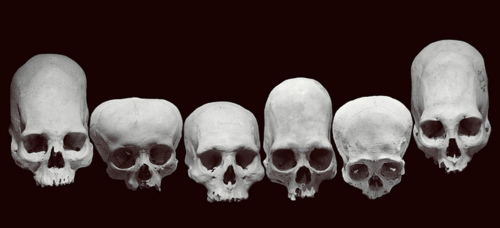
NOVA Looks At How Life and We Got Here
Was the Human Species Shaped By an Alien Agenda?
Hereinafter is a hypothetical consideration. If aliens did at one time, come upon earth and saw it as a perfect environment for life, the aliens for all intents and purposes would not themselves be able to inhabit earth in reasonable comfort for the reasons cited for any unaltered human, animal or plant to inhabit Mars today. They would have to engineer or refurbish their own life forms to make it suited for the unfamiliar (to them) conditions in order to affect their purposes on the earth. These erstwhile gods of ancient times took it upon themselves to modify existing life, which by now, we know has been on earth from almost the very beginning, in order to do two things. One was to populate the earth with earth “adapted” complex life. Two, to mingle their own DNA in order to adapt future generations of theirs to the new and to them, hostile environment. The interest in this presupposes the concept of a spirit or soul that could inhabit the new bodies. This may have been a long term process, or, it may have been a rapid development. In any event, they did not directly inhabit the earth, but chose instead to work from above in the safety of their ships. There are myths in the Bible and elsewhere about beings descending from the sky and interbreeding with human beings. But this interbreeding program may have been done in a manner not involving sex, but genetic modification. Today, as we ponder how to revive the wooly mammoth, the suitable host would likely be an elephant as there are no mammoths today. It might be that proto-humans, however defined, were merged with other kinds of DNA at the cellular level and were raised in some suitable host until born. These then were abducted from the host parent and raised by the ones who did the DNA rearranging. A long term space living civilization may not need to live on a planet, but may require some kind of labour force to mine much needed resources. This hypothesis would answer the question as to why hierarchical civilizations on earth that appear to have been the norm since the dawning of civilization.
We do not know if and when any outsider arrived at earth. We do know that there are plenty of sky myths that indicate that human beings came from the sky, at least in part, if not in whole. Depending on when they arrived, Earth would have been completely different in all six great geological epochs. In the first and longest period, the earth would have been inhabited solely by microbes, and all of these in the oceans. Life only began to become complex some 570 to 530 million years ago, when oxygen levels in the ocean and atmosphere would allow for its emergence. From that period, there are five great epochs marked by catastrophic change between each one. Each one of these epochs would have presented an entirely different biota and climate, as is now fairly well established. Perhaps the easiest time for intervention would have been sometime prior to the Cambrian explosion 530 million years ago. After that, intervention would have consisted of DNA modification of existing species, engineering many for different roles and refurbishing others for future roles. What we do know, is that 530 million years ago, there was a rapid development of complex life all at once across the breadth of species from what was primarily microscopic before. Also, after each great catastrophe, life was renewed, but radically different in each epoch. The epoch prior to ours was the dinosaur period. We now live in the mammal epoch. Each epoch is separated by a major world catastrophe. Is it possible that even this was engineered?
There are three main kinds of mammals, of which two are the marsupial variety and the placental; the most common. The interesting thing about these two is that the individual forms are a close copy of each kind that fill similar ecological niches. For example, there was at one time, before driven to extinction, a marsupial tiger that looked much like the tigers most of us are familiar with and they lived similar lifestyles. Given that mammals inhabit all kinds of niches, might we be looking in the wrong area for our closest cousins? Mammals that live in isolation from each other, develop differently due to the requirements of local environmental conditions as a result of natural selection. Some live in the sea such as the cetaceans, seals and the like. Some have taken to the air and live like birds. The amazing variety and completely of all the various mammals leaves the arena open to other possible relatives than the apes, which look similar to us, but do not have the right cellular biology to be our direct relations.
It is considered that life came to earth from the outside and that it predates earth considerably. The cosmos as we know it, appears to us to have formed some 13.7 billion years ago, assuming a closed cosmos, which now is under question with new findings on the nature of the big bang. Scientists and cosmologists think that conditions were right about 11 billion years ago to allow for the emergence of life, but fail to answer how that life emerged from dead matter. Given a pre-existant cosmic species, the oldest advanced ones in the cosmos, could possibly be as far in advance of us on earth today as humans are to viruses. The popular idea about earth being seeded from the outside is called panspermia and it involves spores and microbes that can withstand the intensely hostile environment of deep space. These would emerge from ancient planets that may well be no more and spread throughout space to land everywhere there are stars with planets, moons and anything else; even on rogue planets. Very few would be suitable to allow life to flourish, but once that happened, then life would flower anew. Such a case is earth and the proof of panspermia would be the finding of viruses and spores in places like the moons of the planets, on Mars and even on asteroids and comets. Perhaps one proof lies in the fact that missions to Mars are banned from returning to Earth with a sample on the risk that Martian microbes might wipe out life as we know it on Earth. Going into space and colonizing planets and moons should not be too difficult a task to follow up as humanity is emerging into the space epoch of development. If indeed, life is common, but dormant in most of the cosmos, findings like this this would go a long way to establish the case of life preexisting the earth.
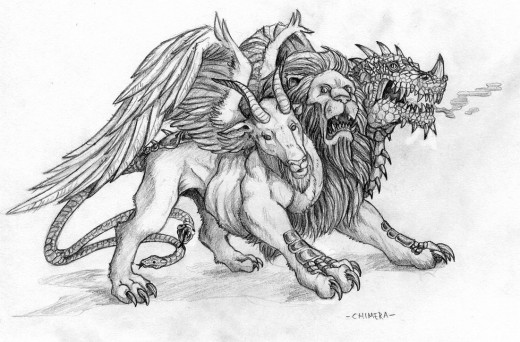
Weird Experiments of Species Interbreeding is a Blind Alley
We now consider human evolution from an unknown ancestor. We are forced into this as it is impossible to have a human offspring from any ape ancestor by species interbreeding alone. It is not even known if we could raise a human embryo in an ape womb or visa-versa, despite experiments going back as far as 1901. There has been thought and considerations in creating a humanzee, a cross between a chimpanzee and a human being, but the problem is that the chimp has 24 sets of chromosomes and the human only 23. It is not anything like mating a horse and a donkey to get a third animal, the mule or hinny. If experimental biologists ever succeeded in making a humanzee or a chimpuman, it would likely be infertile, incapable of ever having children. Examining our own DNA, we find that there are no loose, single strands such as found in the mule and hinny. Occasionally, we will find people with three sets of DNA that arise in a peculiar circumstance. The result of such a merger, is a mongoloid child with mental and physical handicaps. If human beings came from a remote ancestor, that being is now extinct or at least unknown. One possible consideration is the Neanderthal, but they co-existed with Cro-Magnon for a long time before it was thought that Neanderthal went extinct almost 13,000 years ago. It is even though that the two species were capable of interbreeding and creating a cross, some of which some biologists consider to be among us today. But the ancestor to both appears to be lost in the mists of prehistory for the moment. There has not been found, any earlier ancestor and no positive link between humans of any type to apes.
What would be of interest if such an ancestor is found, is to attempt to obtain a full set of chromosomes to see what the structure is of that individual at the cellular level. It is clear from the foregoing that that number would have to be 23 pairs in order to have any semblance of a working breeding program. If we find one with 23 pairs and a single loose strand, then that would cinch the idea of breeding from an ape of some sort that resulted in a sterile offspring. So far, to our knowledge, such a missing link has never been found, nor is it too likely we would find any with intact skeletons, let alone a full set of DNA.
Consider for a moment a catastrophe and the role that plays in sped up adaptation to a wild environment. Some catastrophes could induce DNA splitting where individuals born would wind up with more pairs than their parents. In this case we are faced with the scenario that all other apes are the children of humanity. This idea is as unfounded as traditional evolution as taught in most faculties of education. It also flies in the face of commons sense considered in evolution where more complex life evolves out of the simpler versions, however, such possibilities are not entirely ruled out. Consider what intense ionizing radiation can do and we can find that scrambling of the DNA and even splitting of chromosomes is in the realm of possibility. Outcomes in regions where radiological weapons have been deployed or in regions where nuclear meltdowns have occurred, have shown a marked increase in birth defects, DNA and chromosome changes. As far as known, all of these changes are detrimental, leading to high rates of cancer in children and adults and birth defects in newborns, some of which are stunning. We know at least that ionizing radiation is at least one cause of genetic mutations, including damage to genes, and even chromosome splitting. We know about such things now, owing to our use of radiological elements in various ways.
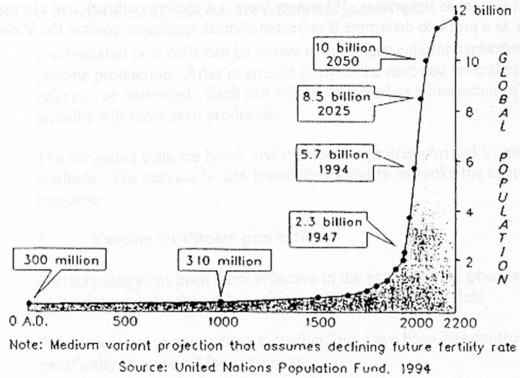
Epigentics is a Clue to Adaptation to Environment
Some Day, We Will Have To Square Off With Our Own Possible Extinction
As the earth itself will one day certainly perish owing to the sun bloating and ending its life, humanity may be faced with the daunting task to relocate to more suitable digs. If we are to save the biota of the earth, we are faced with a task that would be like Noah's ark on steroids! Our massive planet hunting missions have turned up several promising candidates for exploring and perhaps even inhabiting. Many more will likely be found. This of course, is something that is projected into the future by at least 300 million years while the sun still allows life on earth as we know it and provided, we do not destroy ourselves by our own industry and wars. In the meantime, we are going to have to do some practice runs by inhabiting the moon, Mars, asteroids and other planetary moons and even the vacuum of space itself. We will have to learn how to manufacture totally self contained, interstellar arks in order to transport ourselves and biota long distances through a hostile environment of intergalactic space. When we finally arrive at a somewhat suitable destination, then we will have to engineer and refurbish our biota and selves in order to live conformable in the totally new and alien environment. Those that are not re-engineered and refurbished will be stuck in space to observe and manipulate from a distance, to visit from time to time in protective personal environments. All of this will take skills that are either in the early stages of development or that have to be developed from scratch. Chances are that when we arrive at a suitable location, there will be life there already. Some hard decisions will have to be made. Humanity may end up working with the existing biota to integrate it with our own. So then, is it possible that this has happened in the past? Certainly there has been periods of high technological civilization in the past in human history. The discovery of Ooparts has proven much in this area of paleontology.
We are already doing gene mixing from totally unrelated species and this is part of what genetic modification is all about. Fish genes have been incorporated into tomatoes for reasons that are unclear, but it has been done. Usually we hear of folks in Monsanto splicing genes into food crops, like corn and soy beans. to make them resistant to bugs and the popular herbicide “Round-Up” This means that some crops are “Round-Up” ready and can be sprayed with powerful toxins that will kill every other plant except the Monsanto GMO “Round-Up” ready crop. These toxins however, have not been proven safe for human consumption and controversy has erupted over the use of this particular crop. But what is more disturbing is a bid to control all food crops with the introduction of terminator seeds into the environment. Genes have a way of spreading to non-GMO crops and there is an entire legal industry geared around patent infractions with heavy lawsuits to those who wind up with GMO crops due to cross pollination. The spread of terminator genes into the gene pool is potentially catastrophic. So, at least in part, we have proven that DNA can be cross transferred between variants of a species, between engineered and natural ones.
When an earth shattering catastrophe does come about, it is hoped that humanity and some of the biota of earth will already be inhabiting other parts of the solar system. Earth shattering catastrophes of all kinds have already occurred and have sent 99% of all species that ever lived to extinction. Many cosmologists tell us that spreading out into deep space is humanities best chance for survival, that is, to be spread out across the solar system and even across the galaxy in a bid to avoid total extinction if we remain in “one basket” like the proverbial eggs.
Of all the variables that have been considered, them most accurate description is the one that says life evolves by adaptation to changes in the environment. As the environment is undergoing constant change, life has to change along with that. Within the genome is the instruction that will accommodate a reasonable amount of environmental variability, such as we see with wet and dry spells, hot and cold. But when changes are too drastic, there is a chance for extinction. The larger, more complex plants and animals are at the greatest risk. This is not so for the smaller, less complex ones. Within the experience of genetic modification that is practised on crops to fend off pests, it has been found that after several generations, the pests not only adapt to the change in their food, they thrive on it to the consternation of those who invested so heavily in GMO crops. Consider also how pathogens that create disease become resistant to anti-biotics. Humanity now finds that miracle medicines no longer work and must re-invent the whole process of dealing with illnesses like flu, TB, streptococcus and many others. This is something that has been found in a lot of other instances as well. This suggests that all the tools are already in the genome and when changes come, those that allow for adaptation to come to the fore by some feedback process with the environment and the ones adapted to the change survive, whereas those that are already fixed to an old condition, die off. This then is one of the crucial ways evolution is driven. It is obvious that the environment constantly changes and it is apparent the life also changes along with it. As this is a combined and uneven process, some of the old forms survive, sometimes for hundreds of millions of years and many are relatively new. Another way of adapting to change is exhibited by extremophiles. It could be that the wonderful variety that we see in life today, was the result of adapting to varying environments in a combined and uneven manner. This however, is only part of the puzzle and there are other processes at work. Lately, we are one of them.
Humanity has played a part in being the agent that drives adaptation. No where is this more clear than in a rather brutal fact of history. From the mid 16th century until the mid 19th century, some ten million African derived slaves were shipped across the Atlantic in horrible, overcrowded and filthy conditions. These were so bad that 80% of the slaves died in transit and were thrown overboard to feed the sharks. Only two million, or 20% survived the horrific passage. Of these, many were worked to death or executed for not following the orders of the slave driver and masters of sugar and cotton plantations. What this achieved was the weeding out of all those who were not fit enough to survive such brutal extremes, resulting in a larger than chance birth of very fit individuals. These tough offspring would go on to be star athletes in every conceivable athletic endeavour. Take a look at the average young African American person versus the young white American. The difference is stunning as the African American looks strong and fit, despite the horrendous experiences of all his or her predecessors. Indeed, the strongest of them survived and reproduced to create a race of extremely fit individuals. There are exceptions of course, but any athletic endeavour is often predominantly filled with African Americans, sometimes to the total exclusion of any other ethnicity. The adaptation to the environment here consisted of the almost impossible conditions in the trans-Atlantic passage, often lasting months with starvation, scurvy, fierce storms and disease that created from the survivors, a race of supermen and superwomen that could survive unbelievable odds and come out alive and on top. One of the watersheds of this was in the 1936 Olympics in Berlin when an African American competitor, Jesse Owens in track and field beat all the other athletes in the sprint, shamming Hitler and the German supermen that were supposed to win but failed in the face of the real superman. Jesse Owens did this several times to take gold in the various track and field Olympic events. It is somewhat ironic that Hitler et al, attempted to create their own supermen by selective breeding and failed, whereas, a manufactured natural environment in slave prison ships and brutal plantations shaped the African American inadvertently into the very paragon of human athletic perfection the Nazis struggled so hard to achieve. Of course, it took a few centuries to create this adaptation, but adaption to a brutal environment is certainly what happened and human beings inhumanity to other humans drove it. White Americans by comparison, lived soft lives and this also shows over the generations by way of degeneration. Adaptation is a two way street! The result is that African Americans repeatedly show up as more physically fit than their white American peers, contemporaries and counterparts. The same is true in all other countries that ran chattel slave economies where the African was put to brutal exploitation with little reward except a stronger constitution. These are unarguable facts of history and serve to demonstrate the validity of evolution within adaptation to environment conditions over successive generations. The evidence along these two tracks, that of pests and diseases, and of humans thriving and improving in brutal circumstances are among us today complete with all the records of the past. This does not argue for the brutal and ill treatment of others, but is nonetheless, a fact of history.
Chance events have been suggested as being behind all the complex forms including life. Life it appears, can not have arisen due to a chance confluence of random events. Nor did it evolve in the way we have considered evolution to have unfolded. Evolution is not entirely excluded from the picture, but forms an integral part of living development. Life was not created “out of thin air” either, but indications are that some massive intelligence was involved in shaping life to the existing conditions of the cosmos and it may be shaped for each suitable living environment.
References:
Water bear:
http://en.wikipedia.org/wiki/Tardigrade
Cambrian explosion
http://evolution.berkeley.edu/evosite/evo101/VIIB1cCambrian.shtml
Manufacturing artificial life
http://usatoday30.usatoday.com/tech/science/discoveries/2010-05-21-genome21_ST_N.htm
Chromosome count
http://www.walterreeves.com/uploads/chromosomesmtr.htm
Adaptation to extremes
http://anthro.palomar.edu/adapt/adapt_2.htm
GMOs now have an unnatural DNA base pair
http://www.zmescience.com/medicine/genetic/organisms-unnatural-dna-09052014/

